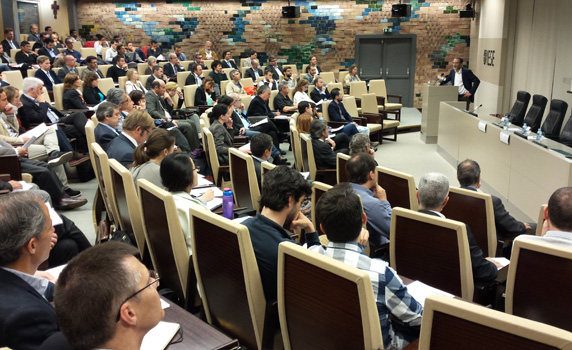The insurance industry is emerging strong from the crisis, increasing its solvency margins by 18 percent in recent years. It is also undergoing renewal as a sector, and preparing itself for new challenges.
These were the conclusions drawn by participants of the 5th Insurance Industry Meeting, organized by IESE’s Center for International Finance (CIF) in collaboration with Ernst & Young (EY).
During the meeting which was hosted by IESE Madrid on April 15, experts agreed that a series of trends will shape the development of the insurance industry in the short and mid term: The European Solvency II Directive, digitization, internationalization, evolving customer relations and the growth of products related to health and assistance.
Solvency II
Starting January 1, 2016, the full implementation of Solvency II will strengthen the insurance sector not only in Spain, but throughout Europe. This directive aims to improve products while increasing oversight and limiting risk (with respect to the market, operations, credit and liquidity).
Solvency II is structured on three pillars: the quantification of assets, liabilities and capital; an oversight process; and transparency requirements.
The directive will compel the European industry to grow, to harmonize its practices, and to become both more dynamic and more solvent.
"But let’s not mistake ‘harmonize’ for ‘homogenize.’ The insurance industry in Europe will only grow if it analyzes the needs of the societies it serves, if it respects local uniqueness and if it opens itself up to competition," said UNESPA President Pilar González de Frutos.
The experts predicted that Solvency II will help harmonize the industry and promote growth. "We all want it to work," they agreed.
Internationalization to Find New Revenue
The recent crisis forced many companies, including Spanish ones, to expand into other markets in search of new revenue. Insurance companies have also increased their presence on the new global scene. Technology has facilitated the internationalization process. In addition, strategic diversification has helped insurance companies minimize risks and take advantage of business opportunities in other geographic areas.
The experts agree that the key to success is to adapt the business model to local needs without forgetting the big picture, and this requires being flexible. "It is essential for the matrix organization to function well and this is not always easy. Another challenge are cultural considerations: you have to understand customers and adapt to their needs," pointed out Ignacio Izquierdo, CEO of Aviva.
But being global merely for the sake of being global doesn’t make sense. Insurance companies have to be selective and compete only in the markets in which they can give value to their shareholders, he said.
Digitization and Innovation
The industry must adapt to new technologies to ensure its future. Digitization is a pressing need; it will affect the corporate culture and the marketing model of each company. Digitization will force the industry to rethink all its procedures. Only those insurance companies that innovate and take risks will grow. Those who don’t may disappear.
"The ability to adapt to change is vital in business," noted CEO of Aegon Spain, Jaime Kirkpatrick. According to Managing Director of Insurance for Mutua Madrileña, Juan Hormaechea, digitization offers insurance companies "a completely unknown world," which will facilitate the customization of products and will allow companies to reach the ideal customer more easily.
Focusing on the Customer
Another effect of digitization is that it dramatically changes customer relations. An important percentage of new customers buy insurance via the web, social networks and mobile platforms. As we know from other industries, such as banking, the process is irreversible.
This forces companies to simplify processes in order to make it easier to purchase insurance online. "Customers need to be at the center of this technological process, which is going to allow us to segment products very well. Everything we do should be focused on the customer," explained Óscar Herencia, general manager of MetLife Iberia.
This segmentation allows insurance companies to offer products that are increasingly adapted to the needs of customers. "Customers and technology are the most important things at the moment," said Marketing and Sales Director of Axa Assistance, José Félix Cañas.
Health and Long-term-care Insurance
The aging population means that more and more people are buying health insurance and, to a lesser extent, medical reimbursement plans.
Top executives of three major insurance companies specializing in health (Asisa, Sanitas and SegurCaixa Adeslas) called for greater collaboration between the private and public sectors for health management, which would "take the pressure off public hospitals." According to them, citizens should be able to choose between public hospitals and private facilities.
Enrique Porres, CEO of Asisa, explained that other countries have developed rules that make it possible to reduce the pressure on the public health system with the support of insurance companies. The speakers warned that Europe has a serious sustainability problem because the cost of the public health system is expanding faster than economic growth.
In terms of long-term care, the participants agreed that without public-private collaboration, it will be impossible to develop an effective approach to caring for dependent persons.
Excellent Assistance Policies
Extended warranty, travel, family, legal, health, home, road... The array of assistance offered is extensive and, in the case of Spain, its quality is exceptional.
"Spain’s assistance policies are among the best in the world," noted Juan Carlos Guzmán, CEO of Mapfre Assistance. So much so that countries like China and the U.S. have begun to adopt the Spanish model, which prioritizes direct and constant contact with the customer and solves problems by providing services rather than merely writing compensation checks.
![]()

















